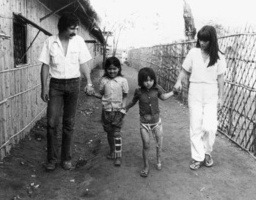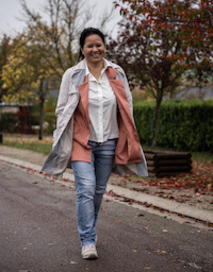Today, Emilie is 48 years old and living in Aube, in the east of France. She was born in Battambang, Cambodia. In 1982, she was fleeing from the Khmer Rouge with her family when she lost her left foot in a landmine explosion. After arriving at Khao I Dang camp, she crossed paths with HI, which had just started up. Emilie was one of the first people to be fitted by HI with a bamboo prosthesis. She tells her story.
The landmine explosion
"At the time, there was a war in Cambodia. Because of the Khmer Rouge's hold on the country, my family had to flee their village. Which is why I found myself on the road, between Thailand and Cambodia.
One day, as we were travelling, we stopped at a refugee camp near a pond. We had come a long way and, like the other children, I was eager to make the most of the cool water. So I waited until my parents fell asleep and sneaked out to go for a swim.
On the way to the pond, we passed some men running in the opposite direction. As they went by, one of them pushed me and I fell onto a landmine. There was a deafening bang. After that, all I remember is a black veil descending. Everything went dark. When I awoke, I saw that my left foot was gone. It had been torn off in the mine explosion.
Arriving in Khao I Dang refugee camp
I received emergency first aid but, for proper treatment, I had to go to another refugee camp in Thailand. It was a long way away and my family carried me through the forest on a stretcher for 15 days, with no medicine, no painkillers - nothing. When we arrived at Khao I Dang camp, I saw many people with missing arms or legs, most of them children.
I was taken to the clinic, where they took off my bandages. It took at least five minutes and I remember very well how the white cloth suddenly turned red. Once the bandages were removed, the doctors could see that gangrene had started to spread up my leg. They decided to anaesthetise me and amputate.
A month later, I came out of the coma. Before the operation, I thought they would amputate below the knee, which would have made it easier to walk again. But when I lifted the sheet, I realised that the amputation was in fact higher up, mid-femur.
HI’s first bamboo prostheses
 There was a workshop making a lot of noise in the camp, and as soon as I could get around on my crutches, I went to see what was going on. In the workshop, there were hammers, pieces of bamboo and iron rods. One of the workers saw me and explained: 'We are making bamboo prostheses for children like you. They will be used for people who have been amputated because of landmines.' I ran back to my parents, shouting, ‘Mummy, there’s a workshop where they are making legs! For children like me!”
There was a workshop making a lot of noise in the camp, and as soon as I could get around on my crutches, I went to see what was going on. In the workshop, there were hammers, pieces of bamboo and iron rods. One of the workers saw me and explained: 'We are making bamboo prostheses for children like you. They will be used for people who have been amputated because of landmines.' I ran back to my parents, shouting, ‘Mummy, there’s a workshop where they are making legs! For children like me!”
That’s when I met the founders of HI. They came to support us and, despite the language barrier, they were training refugees to make bamboo prostheses.
I had to wait for my leg to heal before I could try my first prosthesis. It hurt a lot at first. You have to remember; at the time, there was nothing to reduce the pain. But as soon as I put my prosthetic foot on the floor, I said to myself, 'At last I can walk like everyone else!' Six months after my amputation, I was standing on two feet again. Despite the pain, I wore my prosthesis every day. I played football in flip-flops, played with marbles and bungee cords, danced in the rain... and, like children everywhere, I got up to all kinds of mischief!
Living without limits
 Thanks to the Red Cross, my family was able to move to France in September 1982. The early days were very hard. We came from a country with a totally different culture and, at only six years old, I had witnessed the indescribable horrors of war. Those memories have stayed with me ever since.
Thanks to the Red Cross, my family was able to move to France in September 1982. The early days were very hard. We came from a country with a totally different culture and, at only six years old, I had witnessed the indescribable horrors of war. Those memories have stayed with me ever since.
Growing up, I saw my prosthesis differently. I would meet children who had never seen an amputee before and they fixated on it. They always saw me as the girl with the prosthesis and that really affected me.
Fortunately, my parents always encouraged me not to worry about what other people said and to live my life as I wanted. So I never limited myself. For example, I practiced a lot of sports: 8 years of badminton, table tennis, tennis, football and diving.
Now I live and work here, I have even become a French citizen. But, the more time goes by, the more I miss my other country. Today, my dream is to go back to Cambodia and settle there."



 There was a workshop making a lot of noise in the camp, and as soon as I could get around on my crutches, I went to see what was going on. In the workshop, there were hammers, pieces of bamboo and iron rods. One of the workers saw me and explained: 'We are making bamboo prostheses for children like you. They will be used for people who have been amputated because of landmines.' I ran back to my parents, shouting, ‘Mummy, there’s a workshop where they are making legs! For children like me!”
There was a workshop making a lot of noise in the camp, and as soon as I could get around on my crutches, I went to see what was going on. In the workshop, there were hammers, pieces of bamboo and iron rods. One of the workers saw me and explained: 'We are making bamboo prostheses for children like you. They will be used for people who have been amputated because of landmines.' I ran back to my parents, shouting, ‘Mummy, there’s a workshop where they are making legs! For children like me!” Thanks to the Red Cross, my family was able to move to France in September 1982. The early days were very hard. We came from a country with a totally different culture and, at only six years old, I had witnessed the indescribable horrors of war. Those memories have stayed with me ever since.
Thanks to the Red Cross, my family was able to move to France in September 1982. The early days were very hard. We came from a country with a totally different culture and, at only six years old, I had witnessed the indescribable horrors of war. Those memories have stayed with me ever since.
